The LHC meets industry
Getting beyond technology's teething problems
by Lucio Rossi
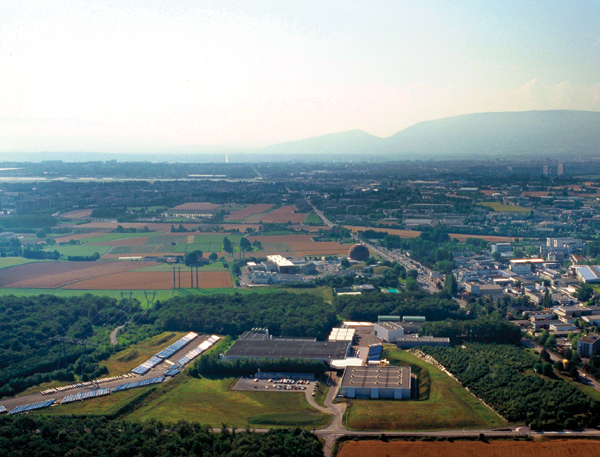 |
| Hundreds of blue dipole magnets sit outside the magnet test facility waiting for installation in the LHC tunnel. |
| Photos: CERN |
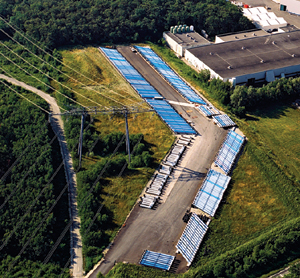 |
Building the parts for the Large Hadron Collider has presented challenges but taught many lessons for both particle physics laboratories and their industry partners.
The Large Hadron Collider is one of the most complex technological creations ever built. About four months from now, the production of components for this machine will be complete, after an effort that has spanned 20 years. We have learned many new skills and processes at CERN, and our industrial partners have had an even steeper learning curve. Of course, many challenges remain as we prepare to operate the LHC, but building the parts has been a vital step.
 |
| Superconducting cables form the heart of the LHC's particle colliding ability. Each cable consists of 6000 coated superconducting wires. Manufacturing the cables took a joint effort between CERN and industry. |
Completing the LHC accelerator is very much a story of learning to work with industry. CERN needed to produce a vast quantity of components, through many manufacturers around the world, and to incredibly exacting specifications. For example, the backbone of the 27-kilometer ring that circulates the protons toward collision consists of 1232 multi-million-dollar dipole magnets. Yet, we can essentially take any magnet from the storage pile and plug it into place in the machine, without thinking much about who manufactured it, or where.
Getting to that point was a turbulent journey, however.
The heart of the LHC: making superconducting wires
The heart of the LHC is based on niobium-titanium (Nb-Ti) superconducting filaments, embedded in compact copper wires for stability and assembled into very compact cables. Fortunately, the basic technology had been developed for the Tevatron collider at Fermilab, and for the abandoned Superconducting Super Collider in Texas.
The challenge of the LHC was repeating the effort with stricter specifications and in larger quantities. Even if we had taken all the production capacities developed for the colliders at Fermilab, Brookhaven National Laboratory, and Deutsches Elektronen-Synchrotron, in Germany, it would not have satisfied the needs of the LHC.
Something supposedly simple, such as obtaining the basic material for the superconducting wires, actually required much coordination. Achieving the highest possible magnetic field for the wires meant the Nb-Ti needed to be exquisitely uniform. Each of the ten thousand 3-inch diameter, 2.5-foot long billets of Nb-Ti was tracked through the production process with a database shared between CERN and the companies supplying the material, such as the Wah Chang company in Oregon, United States.
The biggest manufacturing challenge arose in turning the large ingots of metal into 6-micrometer diameter filaments that were bundled as 6000 strands embedded in a 0.8 mm-diameter copper wire. These thousands of filaments needed to stay uniformly arranged within the copper, all along the 250,000 km of wire.
Identifying the stages of the production process that controlled the uniformity and quality of the wires took the combined effort of CERN and the six companies involved in the manufacturing. Heightening the challenge, each company had a proprietary process for making the wires. Without a solution, the LHC would never work as planned. In the end, the coordination worked and the wire met requirements.
CERN takes a more direct role: Coating the wires
CERN was more directly involved in segments of the wire-production process. For example, once the superconducting wire filaments were made, they needed to be coated with a very thin, carefully-controlled layer of material to prevent them from conducting current between the wires. As happened in many parts of the project, this step brought up a range of issues that could not be anticipated when prototyping components.
At the beginning of the process, we thought we could simply give the manufacturers the detailed specifications for the completed components, and have them deliver what we requested. We discovered there was no way for companies to meet such exacting specifications, without CERN's close involvement.
CERN developed the method for coating the filaments, and for heat-treating the wire that held the 6000 strands, which was then implemented by the manufacturers. This production model became crucial for the further industrialization of the magnet manufacturing process.
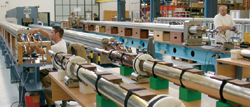 |
| Industry partners manufacture magnets using CERN's designs and processes. By splitting the manufacturing tasks between the laboratory and industry, CERN could ensure high quality while taking advantage of industry's strengths. In the process, industry partners gained new skills that can be put to use in other applications. |
| Photo: CERN |
Designing processes for industry
The production of the dipole magnets saw this same shift in procedure–from CERN providing specifications, with minimal involvement in production, to a CERN-led effort. The final solution had CERN keep control of the intellectual property in the dipole production while providing the detailed design and manufacturing process to the companies for construction.
We took this approach to maintain the economics and quality control for the final product. We sought specific skills from industry: their production organization, and their ability to perform repetitive, though complex, operations with reliable accuracy.
CERN kept control of processes where deep knowledge and the integration of different disciplines were essential, and where the repeatability of a production action did not alone guarantee the success of the product.
As designer of the processes, CERN could introduce new techniques that were not yet standard in industry. One example is the welding of the two lengthwise halves of the magnet shell. CERN developed a new welding technique, which industry partners put into practice for production.
Manufacturing the magnets: A procurement strategy
The final strategy for obtaining the 1232 dipole magnets was to first order a pre-series of 30 dipoles from each of the three companies that were trained during a prototyping phase. This order involved higher costs, allowing for the set up of the factory, and for installing most of the tooling. The second call for tenders for the full series resulted, after strenuous negotiations, in all three companies aligned at the minimum possible price, enabling CERN to grant each manufacturer the construction of 316 units.
If we had contracted for the full series of magnets at the outset, the price would probably have been much higher. Companies did not know ahead of time whether they could learn to produce the magnets more cheaply as they gained experience. The pre-series contract was a way to gain time until confidence was established. In hindsight, the data for Babcock Noell, GmbH (Germany) shows it did learn to improve efficiency, and the lower price for the full series was warranted. The other manufacturers, Alstom MSA-Jeumont (a French consortium) and Ansaldo Superconduttori (Italy), which expect completion of production by October 2006, made similar improvements in efficiency.
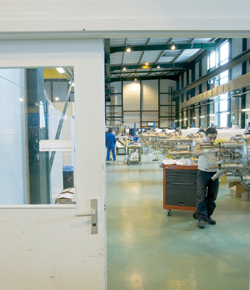 |
| As the final step before installation, magnets are assembled into their cryostats and tested in an above-ground facility at the cold temperatures required while in the collider. |
| Photos: Fred Ullrich, Fermilab |
Unexpected problem: bankruptcy
A different type of story involved some important manufacturers facing bankruptcy. The original company was unable to continue the contract to assemble the cryostat for the collider's short straight sections. CERN re-internalized the work, while inheriting the contractor's sub-suppliers. Although difficult at the beginning, this step has actually saved CERN from paying substantial penalty costs for delayed arrival of those components. In addition, CERN was able to devote its own resources to problems in a system that was much more complicated and subtle than anticipated.
Lessons learned bring advantages for industry and the laboratory
We knew that the industrialization and production of so many complicated components would not be easy. And given the complexity of what we needed, it was perhaps unrealistic to expect companies to produce everything to our specifications, without the specialized expertise found in a particle physics laboratory. Dividing work between the lab and industry to suit the skills of each was vital to completing the project.
We learned that success or failure of a project depended very much on the engineer in charge. Having good people in the lead meant that everybody could adapt to circumstances and solve problems as they arose.
By assigning certain tasks to industry and keeping some within the lab, and changing the balance as we went along, we were able to reap many benefits for both the lab and its industry partners. At CERN, applying our expertise to solve technical problems meant ensuring quality control and saving money.
Benefits for industry were sometimes unexpected. Although people often talk about spin-off technologies from particle physics, our industrial partners gained more value from the new manufacturing techniques they learned.
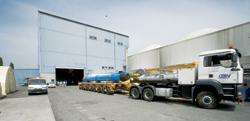 |
| After testing, trucks take the magnets to be lowered down a 100-meter-deep shaft into the tunnel. More than 1200 dipole magnets form the core of the 27-kilometer LHC ring. |
| Photos: Fred Ullrich, Fermilab |
The companies who worked on the LHC are already putting their new skills to work for others. Some companies are making superconducting magnets for magnetic resonance imaging (MRI) machines. Babcock Noell is using its improved welding capabilities in work with other partners. One Italian company learned new ways of working with stainless steel by manufacturing the collars that enclose the magnets. It is now putting those capabilities to work for the car companies Citroën and Peugeot.
Taking a scientific plan on paper, and turning it into a working machine, is an immensely complex task. The transformation has required a special relationship between the lab and its contracted companies, a relationship we had to develop as we went along. As we move toward completion of the LHC, we can see our experiences turning into advantages both for us at CERN and for our industry partners.
Italian professor Lucio Rossi is head of the magnets and superconductors group in CERN's accelerator technology department.
Click here to download the pdf version of this article.


